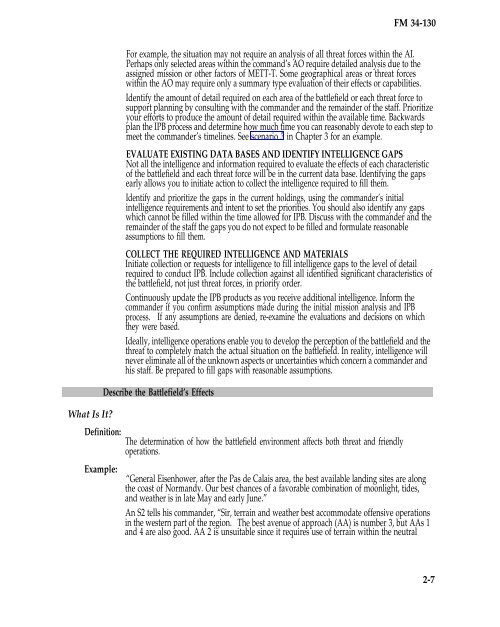Intelligence Preparation of the Battlefield - Federation of American ...
Intelligence Preparation of the Battlefield - Federation of American ...
Intelligence Preparation of the Battlefield - Federation of American ...
You also want an ePaper? Increase the reach of your titles
YUMPU automatically turns print PDFs into web optimized ePapers that Google loves.
What Is It?<br />
FM 34-130<br />
For example, <strong>the</strong> situation may not require an analysis <strong>of</strong> all threat forces within <strong>the</strong> AI.<br />
Perhaps only selected areas within <strong>the</strong> command’s AO require detailed analysis due to <strong>the</strong><br />
assigned mission or o<strong>the</strong>r factors <strong>of</strong> METT-T. Some geographical areas or threat forces<br />
within <strong>the</strong> AO may require only a summary type evaluation <strong>of</strong> <strong>the</strong>ir effects or capabilities.<br />
Identify <strong>the</strong> amount <strong>of</strong> detail required on each area <strong>of</strong> <strong>the</strong> battlefield or each threat force to<br />
support planning by consulting with <strong>the</strong> commander and <strong>the</strong> remainder <strong>of</strong> <strong>the</strong> staff. Prioritize<br />
your efforts to produce <strong>the</strong> amount <strong>of</strong> detail required within <strong>the</strong> available time. Backwards<br />
plan <strong>the</strong> IPB process and determine how much time you can reasonably devote to each step to<br />
meet <strong>the</strong> commander’s timelines. See scenario 3 in Chapter 3 for an example.<br />
EVALUATE EXISTING DATA BASES AND IDENTIFY INTELLIGENCE GAPS<br />
Not all <strong>the</strong> intelligence and information required to evaluate <strong>the</strong> effects <strong>of</strong> each characteristic<br />
<strong>of</strong> <strong>the</strong> battlefield and each threat force will be in <strong>the</strong> current data base. Identifying <strong>the</strong> gaps<br />
early allows you to initiate action to collect <strong>the</strong> intelligence required to fill <strong>the</strong>m.<br />
Identify and prioritize <strong>the</strong> gaps in <strong>the</strong> current holdings, using <strong>the</strong> commander’s initial<br />
intelligence requirements and intent to set <strong>the</strong> priorities. You should also identify any gaps<br />
which cannot be filled within <strong>the</strong> time allowed for IPB. Discuss with <strong>the</strong> commander and <strong>the</strong><br />
remainder <strong>of</strong> <strong>the</strong> staff <strong>the</strong> gaps you do not expect to be filled and formulate reasonable<br />
assumptions to fill <strong>the</strong>m.<br />
COLLECT THE REQUIRED INTELLIGENCE AND MATERIALS<br />
Initiate collection or requests for intelligence to fill intelligence gaps to <strong>the</strong> level <strong>of</strong> detail<br />
required to conduct IPB. Include collection against all identified significant characteristics <strong>of</strong><br />
<strong>the</strong> battlefield, not just threat forces, in priority order.<br />
Continuously update <strong>the</strong> IPB products as you receive additional intelligence. Inform <strong>the</strong><br />
commander if you confirm assumptions made during <strong>the</strong> initial mission analysis and IPB<br />
process. If any assumptions are denied, re-examine <strong>the</strong> evaluations and decisions on which<br />
<strong>the</strong>y were based.<br />
Ideally, intelligence operations enable you to develop <strong>the</strong> perception <strong>of</strong> <strong>the</strong> battlefield and <strong>the</strong><br />
threat to completely match <strong>the</strong> actual situation on <strong>the</strong> battlefield. In reality, intelligence will<br />
never eliminate all <strong>of</strong> <strong>the</strong> unknown aspects or uncertainties which concern a commander and<br />
his staff. Be prepared to fill gaps with reasonable assumptions.<br />
Describe <strong>the</strong> <strong>Battlefield</strong>’s Effects<br />
Definition: The determination <strong>of</strong> how <strong>the</strong> battlefield environment affects both threat and friendly<br />
Example:<br />
operations.<br />
“General Eisenhower, after <strong>the</strong> Pas de Calais area, <strong>the</strong> best available landing sites are along<br />
<strong>the</strong> coast <strong>of</strong> Normandy. Our best chances <strong>of</strong> a favorable combination <strong>of</strong> moonlight, tides,<br />
and wea<strong>the</strong>r is in late May and early June.”<br />
An S2 tells his commander, “Sir, terrain and wea<strong>the</strong>r best accommodate <strong>of</strong>fensive operations<br />
in <strong>the</strong> western part <strong>of</strong> <strong>the</strong> region. The best avenue <strong>of</strong> approach (AA) is number 3, but AAs 1<br />
and 4 are also good. AA 2 is unsuitable since it requires use <strong>of</strong> terrain within <strong>the</strong> neutral<br />
2-7
















